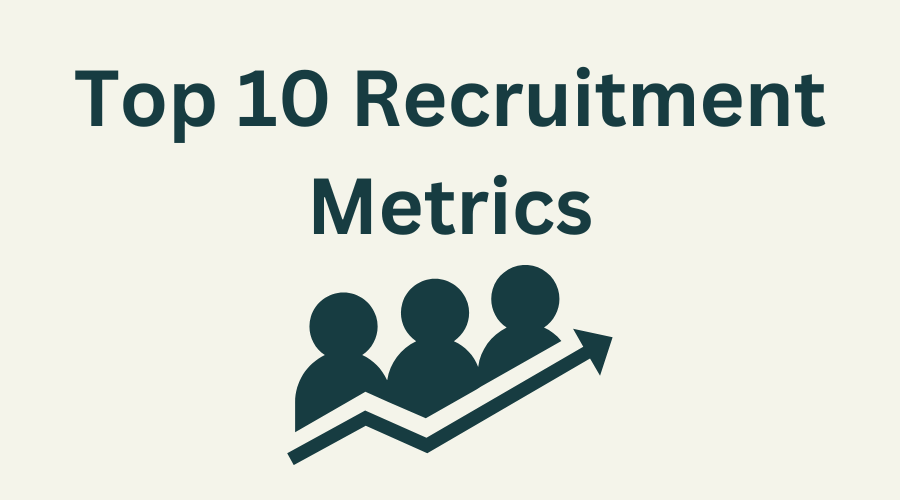
Top 10 Recruitment Metrics You Should Know in 2023
Recruitment is a crucial function of human resources, and data-driven insights are necessary to bring in the best talent and optimize the hiring process.
Tracking recruitment metrics helps recruiters and talent acquisition teams evaluate how successful they are in finding and retaining top talent.
In this post, we'll explain the top 10 recruitment metrics that will give you insight into your recruitment process and help you make smarter hiring decisions. Some of these aren't necessarily critical metrics but they are the most common.
1. Time to Hire: This metric measures the amount of time it takes to fill a job opening from the moment it's posted until the candidate accepts the job offer. A shorter time to hire means quicker access to top talent and improved productivity, while a longer time to hire may indicate market saturation or inefficiencies in the hiring process.
2. Source of Hire: This tracks where candidates come from, such as job boards, referral programs, career websites, or social media. The data can help recruiters direct their recruitment advertising to the most effective channels and build a pipeline of candidates from optimal sources.
3. Offer Acceptance Rate: This calculates the percentage of candidates that accept job offers. A high acceptance rate indicates satisfaction with the job offer and recruitment process, while a low rate could mean a need to improve the company's employer brand or to offer more competitive compensation packages.
4. Cost per Hire: This measures the amount of money spent on recruiting a single candidate. It includes job advertising fees, salaries of recruiters, and other expenses, divided by the total number of hires in a specific period. The metric helps recruiters identify areas where they can cut recruitment costs and optimize their hiring budget.
5. Candidate Experience: This evaluates how candidates feel about their overall recruitment process, including the job application, communication with recruiters, scheduling, and feedback. A positive candidate experience boosts employer branding and helps attract top talent to apply for future positions.
6. Quality of Hire: This determines how well new hires perform in their roles and how well they fit into the company culture. Recruiters can measure the quality of hire by tracking performance reviews, retention rates, and how long the employee stays with the company. A high-quality hire means increased productivity and reduced turnover rates.
7. Diversity Metrics: This examines the diversity of the candidate pool and hiring outcomes. It includes the percentage of diverse candidates for each job opening, the diversity of the workforce, and the retention rate of diverse employees. These insights help companies ensure diversity and inclusion in their talent strategy and improve overall organizational performance.
8. Hiring Manager Satisfaction: This assesses how satisfied hiring managers are with the recruitment process and the quality of candidates presented for interviews. It measures the speed of the recruitment process, quality of communication, and the fit of candidates to the job role and organizational culture.
9. Time to Productivity: This measures how long it takes for new hires to become fully productive in their roles. It includes the time spent on training, onboarding, and the completion of probationary periods. A shorter time to productivity means cost savings and ensures the new employee is making a valuable contribution to the organization.
10. Ratios: These are a set of calculations that highlight the relationship between different recruitment metrics and business outcomes. The most common ratio is the applicant to hire ratio, which measures the number of applicants per job opening needed to make a successful hire. Other ratios can provide valuable insights into the efficiency and effectiveness of the recruitment process.
I'll add one more to this list every recruiter should care about.
Conversion rate. How many views does it take on a job posting to convert to an applicant? The answer according to Appcast for the entire job board ecosystem is about 5%. Meaning for every 100 visitors to a job only one will apply.
Employers would do well by incorporating conversion rates (aka Apply rates) into their monthly metrics report.
These recruitment metrics can help recruiters and human resources managers to evaluate and improve their hiring process. They provide valuable insights into different phases such as sourcing, candidate experience, interviewing, hiring, and onboarding. By tracking these metrics, companies can make data-driven decisions based on reliable information and align their recruitment needs with overall business objectives.
Don't underestimate the power of analytics in candidate sourcing and the selection process. Use these metrics, analyze the data, and then act promptly to improve the talent acquisition function.
These recruitment metrics are definitive and practical indicators of hiring success. Start tracking them today to build a better recruitment strategy!


